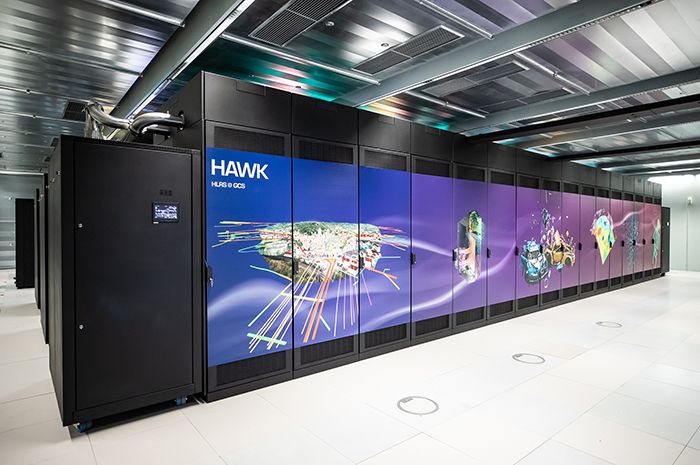NEWSFLASHES
On Latest Top500 List, GCS Centres Expand Computational Performance, Reduce Energy Footprint, and Deliver Diverse Architectures
Newsflash 14/2020 –

The JUWELS Booster module brings the JUWELS system performance to 85 petaflops. The machine also placed 3rd on the Green500 list, making it the most powerful system to achieve such high placement on that list. Image credit: FZ-Jülich/ Ralf-Uwe Limbach.
The latest Top500 list, showcasing the world’s most powerful high-performance computing (HPC) systems, was released on Nov. 16, 2020 during the SC20 conference. In sum, the flagship supercomputers at the three centres comprising the Gauss Centre for Supercomputing (GCS)—the High-Performance Computing Center Stuttgart (HLRS), Jülich Supercomputing Centre (JSC), and Leibniz Supercomputing Centre (LRZ)—all placed in the top 20 of the list. The three machines have a peak of just over 130 petaflops, helping cement Germany’s position as the European leader in HPC space.
This year, two GCS centres installed new machines. JSC, together with hardware partners Atos and ParTec, added to its modular JUWELS system, installing the “Booster” module. The machine did indeed get a large boost—the new partition, featuring NVIDIA A100 GPUs, brought the total machine performance (between the JUWELS Booster and the initial JUWELS module) from 10 petaflops to 85 petaflops. The system was the 7th fastest system on the Top500 list and the 5th fastest on the organization’s alternative HPCG (high-performance conjugate gradient) benchmark.
Unlike the primary Top500 list, which measures performance based on the LINPACK, or a series of dense linear algebra equations, the HPCG benchmark measures performance by running a series of applications that are meant to be representative of typical large-scale scientific and engineering applications running on modern supercomputers.
Additionally, JUWELS placed 3rd in the Green500 list, which measures how many gigaflops a system achieves per watt of energy used, making JUWELS the most powerful machine that high up in the Green500. With these rankings, JUWELS is the most powerful supercomputer in Europe.
“With the JUWELS Booster, the Gauss Centre continues its pioneering role in energy saving and at the same time increases the computational efficiency of its machines,” said Prof. Thomas Lippert, Director at JSC.

HLRS’s Hawk system placed 16th and 18th on the Top500 list and HPCG benchmark respectively. Image credit: HLRS/Ben Derzian.
HLRS also installed its newest system this year, the Hewlett-Packard Enterprise Apollo 9000 system named Hawk. Without the use of GPU accelerators, Hawk achieved 19 petaflops in the Top500 list, coming in at 16 and 334.65 teraflops per second on the HPCG benchmark, placing it 18th. Hawk’s HPCG performance makes it the fastest non-accelerated system in Europe on that list.
LRZ upgraded its flagship system last year, and the Intel-Lenovo-powered SuperMUC-NG system remains among the fastest machines in the world, placing 15th on the Top500 and 22nd in the HPCG respectively. Since SuperMUC-NG went into regular user operation in August 2019, the system has not lost its attractiveness to researchers: It served almost 800 scientists in just over 300 research projects and ran 725,000 jobs, delivering more than 3.4 billion core hours of computing power thus far.

SuperMUC-NG placed 15th and 22nd in the Top500 list and HPCG benchmark respectively. Image Credit: LRZ.
“While we are happy about the appearance of the new GCS systems on the list, it is the science that they will enable which is our main interest,” said Prof. Dieter Kranzlmüller, Director at LRZ and current Chairman of the Board of Directors at GCS. “With the architectural variety we offer as Germany’s three national supercomputing centres, we provide scientists in Germany and Europe with the research infrastructure they need to make a global impact.”
GCS is jointly funded by the German Federal Ministry of Education and Research and the federal states of Baden-Württemberg, Bavaria, and North Rhine-Westphalia. It has its headquarters in Berlin, Germany.
For a complete list of the Top500 rankings, click here.
-Eric Gedenk